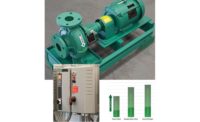Mechanical rooms are incredibly important for building health and safety, not only from an operational standpoint, but also for the building occupants. Building owners or facility maintenance cannot be onsite 24/7 to watch for system errors and make repairs. Thankfully, connected products have helped solve this issue. PM Engineer had the chance to interview Cameron Rapoport, who is a backflow product specialist for Watts, about the growing popularity of smart mechanical rooms.
PM Engineer: What makes a mechanical room smart?
CR: Fortunately for those who own mechanical rooms that may have older equipment and technology — and for those who service and maintain those systems — the technology isn’t necessarily at risk. Older products and technology may not have some of the advantages that the latest, most advanced technology has — but they’re likely reliable and performing just as intended. Older products may not have the latest electronics or self-diagnostics, or Wi-Fi capability, but they likely perform very similarly to the latest technology and modulate or self-regulate operation, though through mechanical means rather than electrically. However, a key benefit to using connected products is the ability to operate more efficiently, thus saving energy at a minimum.
A “smart” mechanical room, in general terms, is a connected mechanical room. Equipment with embedded technology (sensors, processors, controllers) that connects through a gateway or network so it can exchange data with other devices, systems and/or offers users the advantage of sophisticated diagnostics and remote monitoring and control.
The first tier are connected products. These are products that use sensors to be able to do things like increase efficiency, give predictive maintenance notifications, make setup, configuration and commissioning easier and notify users when a valve is discharging or leaking, etc. These products already exist and are performing reliably in mechanical rooms across the globe.
The next tier, providing an advancement that really contributes to mechanical system — and building performance — is in getting all of these products connected together in a system. As more connected products come together, the availability of cloud storage and computing provides a means collecting and putting to use thousands of data points. These are then distilled into useful, real-time and actionable information for the user. Information of this type — gathered and provided quickly — now offers immediate insight into system conditions. It enables diagnosis of the root cause of issues with the system, rather than addressing its components individually. It also allows system optimization — streamlining system efficiency while saving customers time and money.
PM Engineer: Are smart, connected products becoming more popular in today’s mechanical rooms? Why or why not?
CR: Yes, without question. At Watts, we regard these advancements in mechanical system technology as nothing less than a smart/connected revolution. The latest technologies reflect the customer priorities of safety, comfort and efficiency. Also, customers — homeowners or building owners — have made it clear to Watts experts through the years that they prioritize both heating and cooling system operation, and domestic water safety.
Condensing boilers are a vital part of a building’s infrastructure, and are relied on to keep the people in a building comfortable. Smart, connected boilers are able to optimize themselves to increase efficiency, alert users about predictive maintenance and make system recommendations.
Digital mixing valves play a vital role in keeping building inhabitants safe and comfortable, especially in the healthcare and hospitality industries. They are easier to commission than mechanical mixing valves, have more safety features, are more accurate, provide better service (especially under fluctuating conditions) and provide constant feedback to the user through integration with a building automation system.
Backflow preventers are among the newest products in a mechanical room to become smart and connected. As a critical water safety component, reduced pressure zone backflow preventers are designed to release water through a relief valve as a visual indicator of a malfunction in high hazard applications, which in extreme circumstances can cause flooding in a building. By incorporating sensors and communication, backflow preventers can now alert users through cell phones or through the existing building management or automation systems when there may be a potential flood condition, so users can address it before it becomes a more costly issue.
Undoubtedly, we’ll continue to see more connected products, and more value being generated from existing ones as we find new ways to leverage data to improve building systems.
PM Engineer: Why should engineers specify these types of products on projects?
CR: Smart mechanical system products and components are easier to setup and install. And, because products are providing greater value, but are also becoming more complex, it’s important that smart and connected products also provide features that allow a contractor to install and setup complex systems more easily. At Watts, that has been a priority from the start.
Enhanced system performance is especially important in products such as condensing boilers where loss of efficiency can cost customers a lot of money. A neglected or improperly installed boiler could conceivably pose health and safety risks, and would likely also result in loss of operational efficiency, resulting in decreased efficiency. The likelihood of these conditions are greatly reduced with contemporary, connected technology.
These products also provide a lower cost of ownership. Not only in efficiency gains, but in maintenance and repair. Predictive maintenance — maintenance that is performed based on information that indicates failure is imminent — coupled with smart and connected products, enable diagnostics and analysis that prevent problems before they happen. In this way, repairs and maintenance can be done in a planned way, avoiding extra costs or hassle due to emergency repairs or cascading effects of component failure. It also means that contractors can diagnose issues and get the correct repair components faster.
PM Engineer: Anything else you would like to add?
CR: Technology isn’t just about adding features to the product, it's also about making these complex products easier for installers or engineers to specify and configure. More tools, greater flexibility and improved insights all join to help engineers select, specify and configure these products — all in a way that counterbalances their increased sophistication and complexity.




